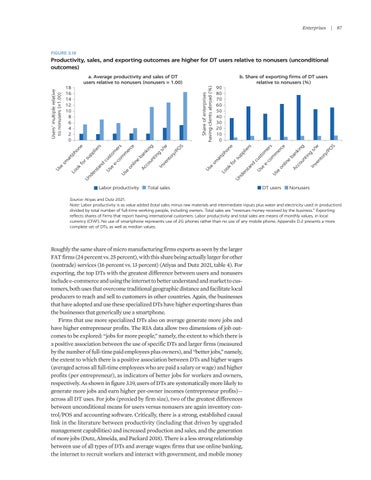Enterprises
|
87
FIGURE 3.18
sm ar tp Lo ho ok ne fo rs Un up de pl rs ie ta rs nd cu Us st om e eer co s m Us m e er on ce lin e ba Ac nk co in un g tin g In s/ ve w nt or y/ PO S
Share of enterprises having clients abroad (%)
Us e
Labor productivity
90 80 70 60 50 40 30 20 10 0
b. Share of exporting firms of DT users relative to nonusers (%)
Us e
18 16 14 12 10 8 6 4 2 0
a. Average productivity and sales of DT users relative to nonusers (nonusers = 1.00)
sm ar tp Lo ho ok ne fo rs Un up de pl rs ie ta rs nd c us Us to e m eer co s m Us m e e rc on e lin e ba Ac nk co in un g tin g In s/ ve w nt or y/ PO S
Users’ multiple relative to nonusers (=1.00)
Productivity, sales, and exporting outcomes are higher for DT users relative to nonusers (unconditional outcomes)
Total sales
DT users
Nonusers
Source: Atiyas and Dutz 2021. Note: Labor productivity is as value added (total sales minus raw materials and intermediate inputs plus water and electricity used in production) divided by total number of full-time working people, including owners. Total sales are “revenues money received by the business.” Exporting reflects shares of firms that report having international customers. Labor productivity and total sales are means of monthly values, in local currency (CFAF). No use of smartphone represents use of 2G phones rather than no use of any mobile phone. Appendix D.2 presents a more complete set of DTs, as well as median values.
Roughly the same share of micro manufacturing firms exports as seen by the larger FAT firms (24 percent vs. 25 percent), with this share being actually larger for other (nontrade) services (16 percent vs. 13 percent) (Atiyas and Dutz 2021, table 4). For exporting, the top DTs with the greatest difference between users and nonusers include e-commerce and using the internet to better understand and market to customers, both uses that overcome traditional geographic distance and facilitate local producers to reach and sell to customers in other countries. Again, the businesses that have adopted and use these specialized DTs have higher exporting shares than the businesses that generically use a smartphone. Firms that use more specialized DTs also on average generate more jobs and have higher entrepreneur profits. The RIA data allow two dimensions of job outcomes to be explored: “jobs for more people,” namely, the extent to which there is a positive association between the use of specific DTs and larger firms (measured by the number of full-time paid employees plus owners), and “better jobs,” namely, the extent to which there is a positive association between DTs and higher wages (averaged across all full-time employees who are paid a salary or wage) and higher profits (per entrepreneur), as indicators of better jobs for workers and owners, respectively. As shown in figure 3.19, users of DTs are systematically more likely to generate more jobs and earn higher per-owner incomes (entrepreneur profits)— across all DT uses. For jobs (proxied by firm size), two of the greatest differences between unconditional means for users versus nonusers are again inventory control/POS and accounting software. Critically, there is a strong, established causal link in the literature between productivity (including that driven by upgraded management capabilities) and increased production and sales, and the generation of more jobs (Dutz, Almeida, and Packard 2018). There is a less strong relationship between use of all types of DTs and average wages: firms that use online banking, the internet to recruit workers and interact with government, and mobile money



